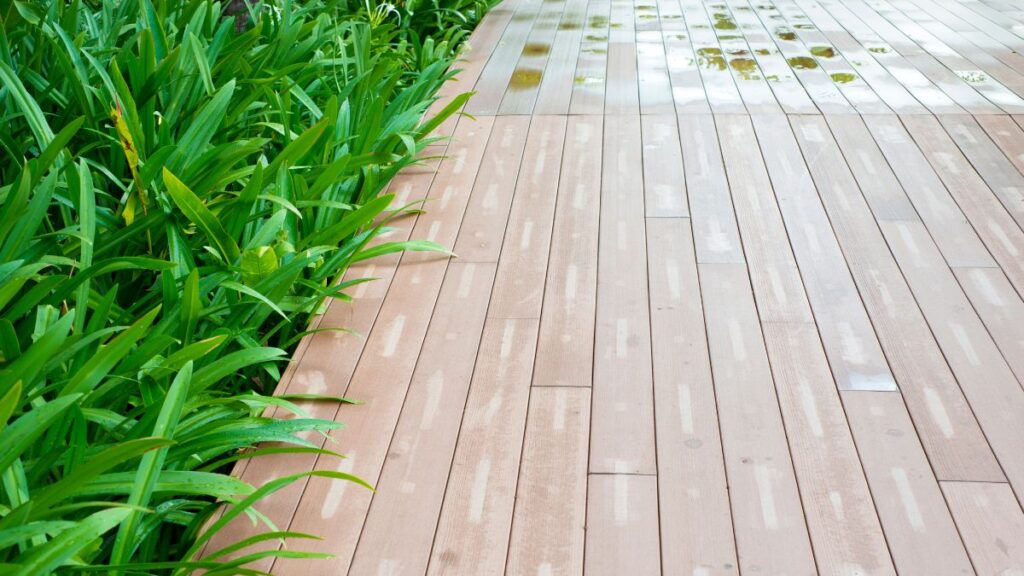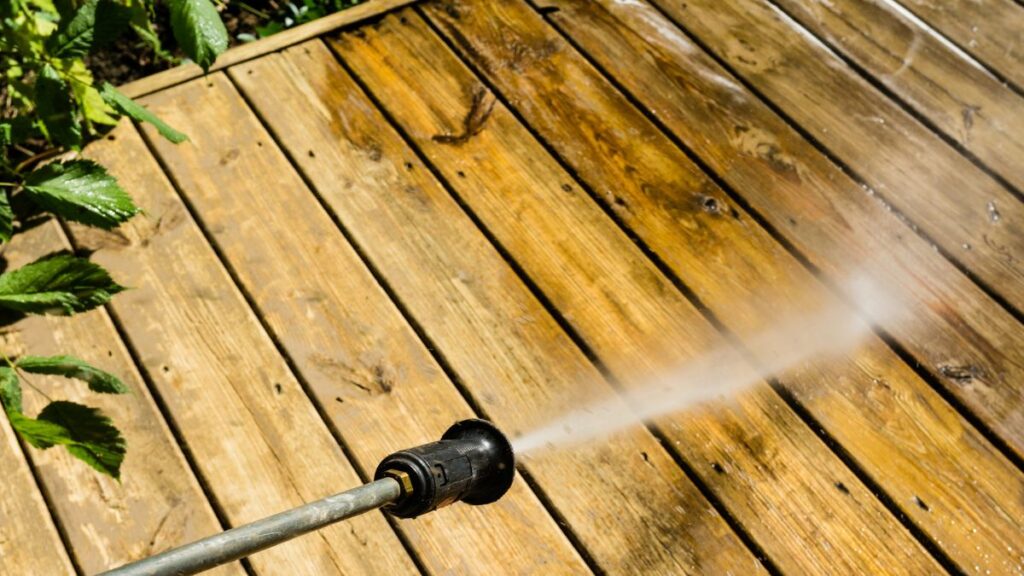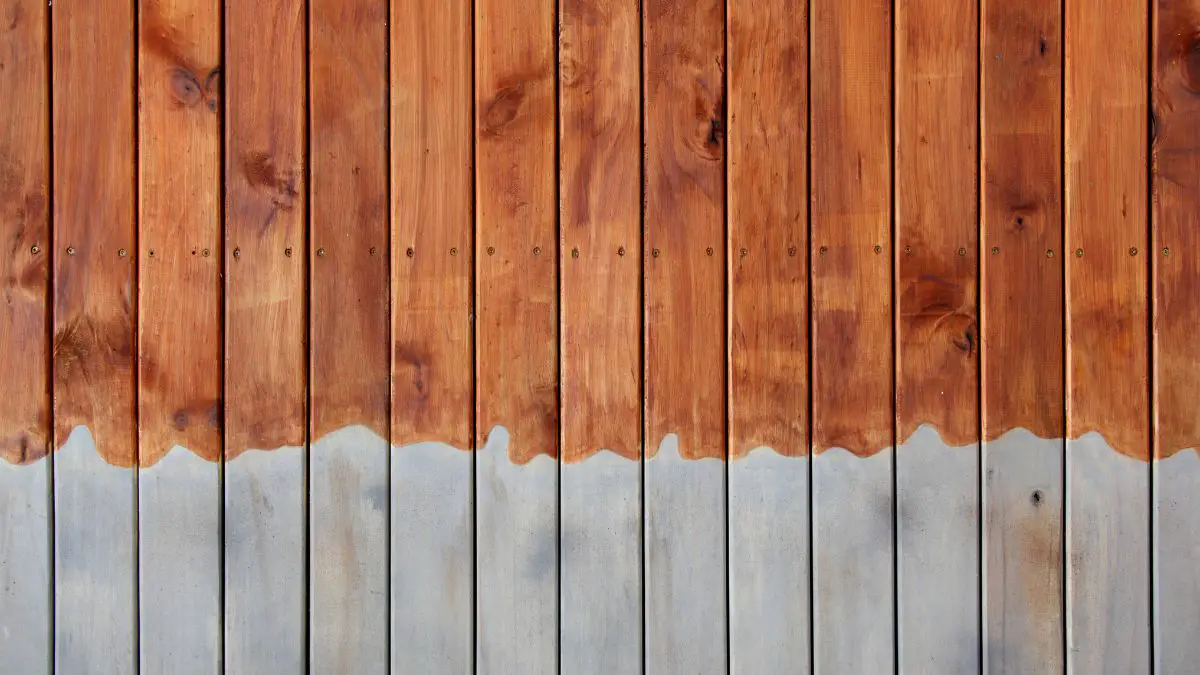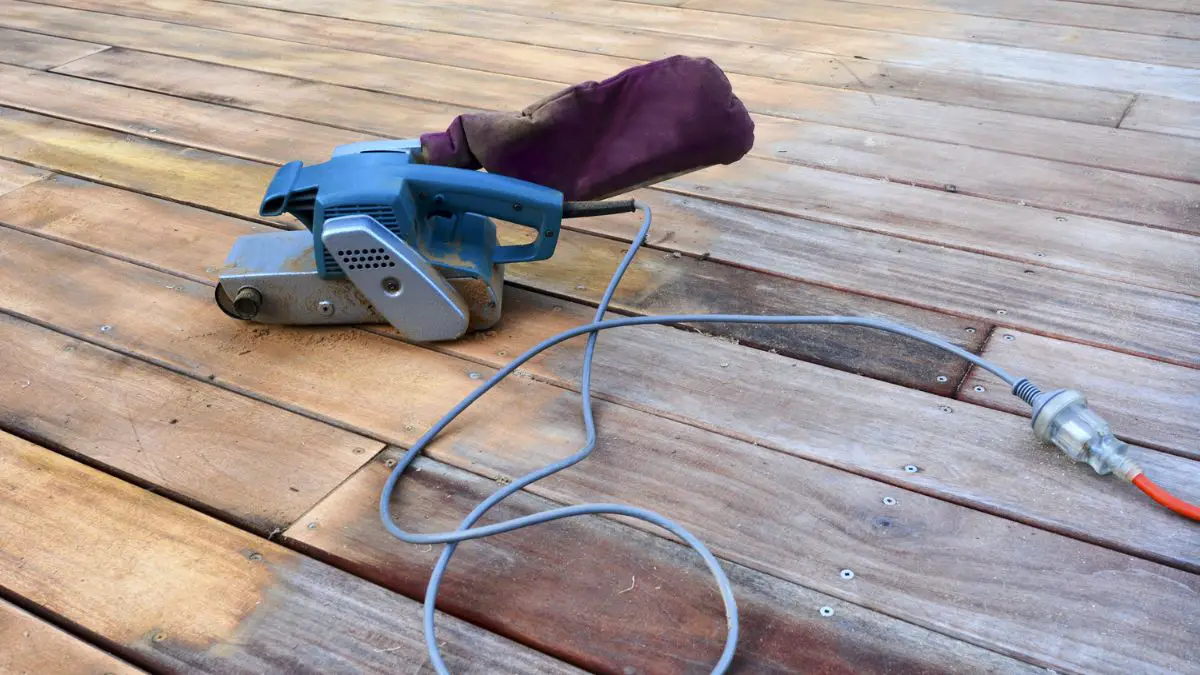You can naturally clean your wood deck using eco-friendly solutions like vinegar, baking soda, or oxygen bleach. Start by:
- clearing and sweeping your deck
- apply your chosen solution
- scrub gently along the wood grain
- rinse thoroughly using a pressure washer or hose with a sprayer attachment to power wash the stains away
Natural cleaning methods are kind to the environment. They don’t contribute to pollution or harm the surrounding plant life. You can maintain your little piece of outdoor paradise without causing harm to the larger paradise that is our planet.

Understanding Your Wood Deck
Before diving into the cleaning process, it’s essential to understand the unique characteristics of your wood deck. Decks can be made from various types of wood with properties and care requirements.
Perhaps your deck is made of pressure-treated lumber, a popular choice for its durability and affordability. Or maybe it’s crafted from beautiful and resilient redwood or cedar woods known for their resistance to decay and insects.
You might even have a deck constructed from tropical hardwoods like ipe or mahogany, prized for their density and rich color.
Common enemies of ugly wood decks
- Mold and mildew are fungi that thrive in damp, shaded areas. They can appear as black, white, or green patches on your deck’s surface.
- Stains can come from a barbecue mishap that left a grease spot, or perhaps fallen leaves have left tannin stains. Even the iron in your outdoor furniture can leave rust stains on your deck.
Why Choose Natural Cleaning?
1. Natural cleaning methods are kind to our planet
Traditional cleaning products often contain harsh chemicals that can harm the environment. When you rinse your deck, these chemicals can wash off into your garden or the local water system, causing harm to plants and wildlife.
You’re making an eco-friendly choice by choosing natural cleaning solutions like vinegar, baking soda, or oxygen bleach. You’re contributing to preserving our environment, one deck cleaning at a time.
Related Reading: How to Refinish a Deck: Essential Steps and Tips
2. Natural cleaning methods are safe for your family
You love spending time on your deck with your children and pets. It’s a place for play, relaxation, and creating memories. The last thing you want is for them to come into contact with harmful substances.
Natural cleaning solutions are non-toxic and safe. Even if your child or pet wanders onto the deck during or immediately after cleaning, there’s no risk to their health.
3. Natural cleaning methods help preserve the quality of your wood
Harsh chemicals can strip away the natural oils in the wood, causing it to dry out and become brittle over time.
Natural homemade deck cleaners are gentle, clean, and effective without causing unnecessary damage to the wood. Your deck stays strong, resilient, and beautiful for longer.

Preparing Your Deck for Cleaning
- Remove all furniture, grills, planters, and other items on your deck. This gives you a clear, unobstructed space to work with and ensures that every inch of your deck gets the cleaning attention it deserves. It’s also an excellent opportunity to clean and maintain your outdoor furniture!
- Take the time to check for any necessary repairs. Look for loose or protruding nails, splintered wood, or damaged deck boards. These issues can pose safety risks and may hinder your cleaning efforts. Addressing them before you start cleaning ensures a smooth, hassle-free process. Remember, a well-maintained deck is more beautiful, safer, and enjoyable.
- Give your deck an initial sweep and dusting. Use a good broom to remove leaves, dirt, and other debris. Pay special attention to the gaps between the boards, where surface dirt and moisture can accumulate, leading to mold and mildew. This initial sweep makes cleaning solutions more effective and helps prevent scratches or damage during scrubbing.
Related Reading: Can You Paint or Stain Composite Decks?
Natural Cleaning Solutions for Your Deck
Now that your deck is prepared, it’s time to introduce you to the stars of the show: natural cleaning solutions. These eco-friendly products and safe, effective wood deck cleaners will become your best friends in deck maintenance.
Vinegar and water solution
Vinegar is a household staple with many uses, and deck cleaning is one of them. This humble kitchen ingredient is a natural disinfectant that can kill mold and mildew, making it perfect for your deck.
To make a vinegar cleaning solution:
- Mix equal parts of white vinegar and warm water in a bucket.
- Stir well to combine.
- That’s it! You now have a potent, natural deck cleaner.
Baking soda and water solution
Baking soda, another kitchen superstar, is excellent for cleaning your deck. A mild abrasive can scrub away dirt and stains without damaging your wood. Plus, it’s great for neutralizing odors.
How to make a baking soda cleaning solution:
- Add one cup of baking soda to a gallon of warm water.
- Stir until the baking soda is fully dissolved.
Oxygen bleach solution
Oxygen bleach (or sodium percarbonate) is a fantastic natural cleaner for decks. It’s a safe, non-toxic bleach that breaks down into oxygen and soda ash when mixed with warm water, both harmless to the environment. It’s excellent for removing algae, mildew, mold, and stains.
To prepare an oxygen bleach solution:
- Mix one cup of oxygen bleach with a gallon of water.
- Stir until the bleach is fully dissolved.
And there you have it, a powerful, eco-friendly deck cleaner.
Applying the solutions
- Choose a cool, cloudy day to clean your deck. Direct sunlight can cause your cleaning solution to evaporate too quickly, reducing effectiveness.
- Wet your deck with a garden hose. This prepares the wood to absorb the cleaning solution better.
- Apply your chosen cleaning solution generously with a sprayer, mop, or soft bristle brush. Let it sit for 10-15 minutes to allow the cleaner to penetrate the wood and do its magic.
- Scrub the deck using a stiff-bristle scrub brush to remove stubborn stains. Be sure to scrub along the grain of the wood to avoid damaging it.
- Rinse thoroughly with a clean bucket of water or a power washer. Make sure to remove all the cleaning solutions to prevent residue buildup.
- Allow your deck to dry completely before replacing furniture or walking on it.
Scrubbing and Rinsing Your Deck
Choosing the right tools
The right tools can make your deck cleaning task much easier. For scrubbing, a stiff-bristle brush is your best bet. Choose one with a long handle to save your back from unnecessary strain.
Consider using a deck brush with stiff, synthetic bristles when dealing with stubborn stains or large areas; it is specifically designed for heavy-duty scrubbing and can quickly cover a large deck surface area.
Scrubbing without elbow grease
Scrubbing your deck isn’t just about applying elbow grease. There’s a technique to it that can help you clean more effectively and protect your wood. Always scrub along the wood grain, not against it, to prevent the wood fibers from being damaged.
Apply enough pressure to remove the dirt and grime, but not so much that you damage the wood. Remember, it’s better to do multiple light passes than one heavy one that could harm your deck.
Rinsing and drying times
Once you’ve scrubbed your deck clean, it’s time to rinse. Use a garden hose with a spray nozzle to thoroughly rinse off the cleaning solution. Pay special attention to the gaps between the boards, as cleaning solutions can get trapped there.
After rinsing, allow your deck to dry naturally. This is an important step, as leaving your deck wet can lead to mold and mildew growth. Depending on the weather, it can take 24-48 hours for your deck to dry completely.
Scrubbing and rinsing your deck may seem like hard work, but it’s worth it. Seeing your deck restored to its natural beauty is a rewarding experience. Plus, you can take pride in knowing you’ve done it safely for your family and the environment.
Post-Cleaning Maintenance for Your Deck
Regular sweeping to remove debris.
One of the simplest yet most effective maintenance tasks is regular sweeping. It helps prevent the buildup of dirt, leaves, and other debris that can stain your deck or encourage mold growth.
Make it a habit to sweep your deck once a week or more often if it is under trees or used frequently. A clean deck is more attractive and healthier for your wood.
Using plant-friendly soaps.
Opt for plant-friendly soaps for a quick clean-up after a barbecue or outdoor dinner. These soaps are gentle on your deck and won’t harm your garden plants or grass. They’re a great way to clean up food spills or bird droppings without needing a full deck cleaning.
Proper storage of outdoor furniture.
Your outdoor furniture can also play a role in maintaining your deck.
- Store your furniture indoors or under a waterproof cover when not in use, especially during winter, to prevent water from pooling on your deck, which can cause water stains or wood rot.
- Use furniture pads under the legs of heavy furniture to prevent scratches or dents on your deck.
When to Seek Professional Help for Your Deck
While DIY natural cleaning is effective for regular maintenance and minor issues, there are times when professional help may be necessary.
Recognizing the signs of serious damage and understanding the benefits of professional cleaning can ensure your deck gets the care it needs.
Signs of serious damage to your wood deck
Watch for signs of damage that may require professional intervention. These can include:
- Deep, stubborn stains that don’t respond to cleaning
- Significant discoloration or fading of the wood
- Rotting wood or areas that feel soft and spongy
- Loose or wobbly boards or railings
- Large cracks or splits in the wood
These issues can compromise the safety and integrity of your deck. If you notice any of these signs, it’s time to call in a professional.
Benefits of professional cleaning.
Professional deck cleaners bring expertise and specialized equipment to the task. They can effectively tackle stubborn stains, deep-seated mold, and other serious issues difficult to handle with DIY methods.
Professionals also know how to clean your deck without causing unnecessary damage. They understand the unique needs of different types of wood and can adjust their cleaning methods accordingly.
Moreover, a professional can inspect your deck for any hidden issues, ensuring that all problems are addressed, not just the ones visible on the surface.
While professional cleaning comes at a cost, it’s an investment in the longevity of your deck. It can help prevent more costly repairs and ensure your deck remains a safe and enjoyable place for you and your family.
Essential Safety Guidelines for Creating Your Own Deck Cleaner
Creating a homemade deck cleaner safe for plants is a smart move. Avoid harsh and toxic chemicals that can harm nearby plants and grass.
Plant-safe homemade deck cleaner.
Opt for non-toxic cleaners like OxiClean, which contains sodium percarbonate, a derivative of hydrogen peroxide. It’s effective for removing various stains and spills, and it’s eco-friendly and biodegradable so that it won’t harm plants or the environment.
Avoid power and pressure washers.
Avoid using your homemade cleaner with power or pressure washers. These machines have small nozzles that create intense water pressure, which can clog with undissolved granular cleaners. With this DIY deck cleaner, the active ingredients do the cleaning, so there’s no need for intense water pressure. A regular garden hose is sufficient for rinsing.
Protect your skin and hands.
When preparing your cleaner, protect your skin and hands by wearing gloves. Even non-toxic cleaners like Borax can cause skin irritation in high concentrations. Wear rubber gloves while mixing and applying the deck cleaning solution, and rinse off any splashes on your skin.
Avoid mixing ammonia and bleach.
Never mix ammonia-based ingredients with bleach. This combination creates toxic chloramine gas, irritating the eyes, nose, mouth, and respiratory system.
Let the cleaner dry before applying treatments.
After using a bleach-based cleaner, let it dry completely before applying treatments like staining, painting, or sealing. Also, wait until the entire deck is dry before repairing, like replacing rusty screws or reinforcing deck boards.
Store cleaner in a well-ventilated area.
Store your homemade cleaner in a well-ventilated area. Even though it’s not considered a toxic chemical, it does have an odor that some might find unpleasant. Since it’s intended for outdoor use, keep it outside until you’re ready to clean your deck and dispose of any leftovers.
Keep the cleaner out of reach of children.
Keep your cleaning solution out of reach of children. While this homemade cleaner is milder than many commercial ones, it’s still a decking cleaner and should be kept away from children.
FAQs
What is the easiest way to clean a wooden deck?
The easiest way to clean a wooden deck is using a natural cleaning solution, such as vinegar, a bucket of water mixture, and a soft bristle brush. Wet your deck, apply the cleaning solution, let it sit for a few minutes, then scrub along the grain of the wood. Rinse thoroughly and let your deck dry completely.
What is the best homemade cleaning solution to clean a deck?
The best homemade solution depends on your deck’s specific needs. cup of vinegar and clean water is a great all-purpose homemade cleaner, especially for killing mold and mildew. Baking soda and gallon water can tackle tougher stains, while oxygen bleach is excellent for deep cleaning and removing algae.
Can I use Dawn to clean my deck?
Yes, Dawn or any other plant-friendly liquid dish soap can be used for quick clean-ups on your deck. However, deck cleaning solutions like vinegar, baking soda, or oxygen bleach are more effective for deep cleaning or tackling issues like mold, mildew, and tough stains.
How do you clean a deck without damaging the wood?
To clean your deck without damaging the wood, always scrub along the grain, not against it. Use a stiff-bristle scrub brush, not metal, to avoid scratching the wood. Also, avoid using high-pressure washers, as they can cause damage. Instead, opt for a garden hose for rinsing.
Is pressure washing my deck a good idea?
While pressure washing can quickly clean your deck, it requires careful handling. Using the correct settings and nozzle is crucial to avoid damaging your deck. Always test on a repairable spot first, and ensure children and pets are clear of the area. While effective, power washing isn’t necessary for a clean deck.







